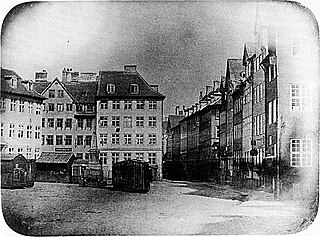
Sally Mann HonFRPS is an American photographer known for making large format black and white photographs of her immediate surroundings—her children, husband, rural landscapes, and self-portraits.

Yevonde Philone Middleton was an English photographer, who pioneered the use of colour in portrait photography. She used the professional name Madame Yevonde in a career lasting over 60 years.

Antoinette Frissell Bacon, known as Toni Frissell, was an American photographer, known for her fashion photography, World War II photographs, and portraits of famous Americans, Europeans, children, and women from all walks of life.
Maison Bonfils was a French family-run company producing and selling photography and photographic products from Beirut from 1867 until 1918, from 1878 on renamed "F. Bonfils et Cie". The Bonfils ran the first and, in their time, most successful photographic studio in the city. Maison Bonfils produced studio portraits, staged biblical scenes, landscapes, and panoramic photographs.
Anna Fox is a British documentary photographer, known for a "combative, highly charged use of flash and colour". In 2019 she was awarded an Honorary Fellowship of the Royal Photographic Society.

Nature photography is a wide range of photography taken outdoors and devoted to displaying natural elements such as landscapes, wildlife, plants, and close-ups of natural scenes and textures. Nature photography tends to put a stronger emphasis on the aesthetic value of the photo than other photography genres, such as photojournalism and documentary photography.

Cristina Goettsch Mittermeier is a Mexican photographer, conservationist, biologist, and author.
Tim Flach is a British photographer who specialises in studio photography of animals. He has published several books of photographs.
Marie Cosindas was an American photographer. She was best known for her evocative still lifes and color portraits. Her use of color photography in her work distinguished her from other photographers in the 1960s and 1970s. Most of her photographs were portraits and pictures of objects like dolls, flowers, and masks.

In Denmark, photography has developed from strong participation and interest in the very beginnings of the art in 1839 to the success of a considerable number of Danes in the world of photography today.
Elaine Mayes is an American photographer and a retired professor at New York University's Tisch School of the Arts.

The participation of women in photography goes back to the very origins of the process. Several of the earliest women photographers, most of whom were from Britain or France, were married to male pioneers or had close relationships with their families. It was above all in northern Europe that women first entered the business of photography, opening studios in Denmark, France, Germany, and Sweden from the 1840s, while it was in Britain that women from well-to-do families developed photography as an art in the late 1850s. Not until the 1890s, did the first studios run by women open in New York City.

Sarah Angelina "Angie" Acland was an English amateur photographer, known for her portraiture and as a pioneer of colour photography. She was credited by her contemporaries with inaugurating colour photography "as a process for the travelling amateur", by virtue of the photographs she took during two visits to Gibraltar in 1903 and 1904.
Alex Cearns is an Australian photographer who is known for her pet, animal, and wildlife photography. She is the founder of Houndstooth Studio and has won more than 350 awards for business, philanthropy and animal photography, including the Best Canine Photographer in Australia in 2011 and 2013. She is the official photographer for the Dogs' Refuge Home of WA and has been featured in numerous books and magazines as well as the television show The Couch.

Sarah James Eddy was an American artist and photographer who specialized in the platinotype process, also known as platinum prints. She was active in abolition, reform, and suffragist movements, and was a philanthropist as well as instrumental in the founding of the Rhode Island Humane Society. She was inducted into the Rhode Island Heritage Hall of Fame in 2017.

Jo-Anne McArthur is a Canadian photojournalist, humane educator, animal rights activist and author. She is known for her We Animals project, a photography project documenting human relationships with animals. Through the We Animals Humane Education program, McArthur offers presentations about human relationships with animals in educational and other environments, and through the We Animals Archive, she provides photographs and other media for those working to help animals. We Animals Media, meanwhile, is a media agency focused on human/animal relationships.
Siân Davey is a British photographer. Her work focuses on her family, community and self, and is informed by her background in psychology.
Thomas D. Mangelsen is an American nature and wildlife photographer and conservationist. He is most famous for his photography of wildlife in the Greater Yellowstone Ecosystem, as he has lived inside the zone in Jackson, Wyoming, for over 40 years. In 2015, he and nature author Todd Wilkinson created a book, The Grizzlies of Pilgrim Creek, featuring a grizzly bear known as Grizzly 399, named so due to her research number. He has been active in the movement to keep the Yellowstone area grizzly bears on the Endangered Species List. Mangelsen is also known for trekking to all seven continents to photograph a diverse assortment of nature and wildlife. A photograph he took in 1988 titled, "Catch of the Day" has been labeled "the most famous wildlife photograph in the world". In May 2018, he was profiled on CBS 60 Minutes. He has received dozens of accolades throughout the decades.

Hold Still: A Portrait of Our Nation in 2020 is a 2021 photographic book published by the National Portrait Gallery centering around the COVID-19 pandemic in the United Kingdom. For the campaign “Hold Still”, the British public submitted pictures taken during the lockdown period of the pandemic for exhibition. Catherine, Duchess of Cambridge, and a panel of experts, including Nicholas Cullinan, Lemn Sissay, Ruth May, and Maryam Wahid, curated the photographs featured in the book.











